Prices in AUD. Shipping worldwide. Flat rate $8 postage per order within Australia. International by weight calculated at checkout. Read full terms.
-
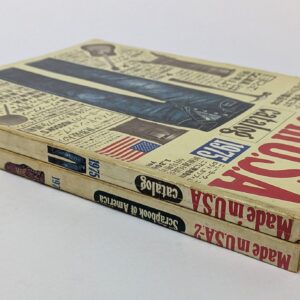

Made in U.S.A. Catalog, 1975 and Made in U.S.A.-2 Scrapbook of America, 1976 (2 Volumes)
AU$550.00 Read MoreAdd to cartYoshihisa Kinameri; Jiro Ishikawa
Tokyo: Yomiuri Shimbun, 1975.Two catalogues of American fashion, culture, tools, and lifestyle products, an earlier project from the founders of Popeye magazine, who travelled the United States to put together these volumes which became a massive driver of American lifestyle and fashion influence in Japanese culture. Today, they remain a detailed catalogue of 1970s American culture. Both volumes include detailed shopping guides to numerous American cities. Unrecorded in OCLC or CiNii,
-
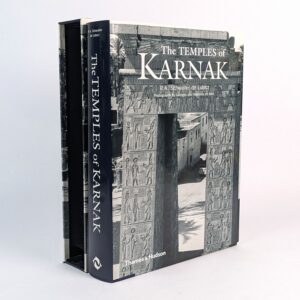
The Temples of Karnak
AU$120.00 Read MoreAdd to cartR. A. Schwaller de Lubicz
London: Thames & Hudson, 1999.Translated from the French Les Temples de Karmak by Andre Vanden Broeck. A complete photographic record of monuments, ruins, statues and the ancient Egyptian temples of Karnak. Includes the land of the Nile, mythology, and royal cartouches from the 18th to the 30th dynasties.
-
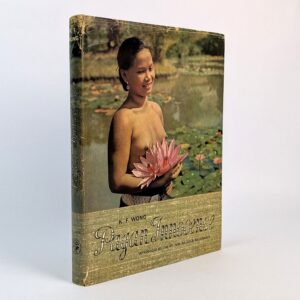
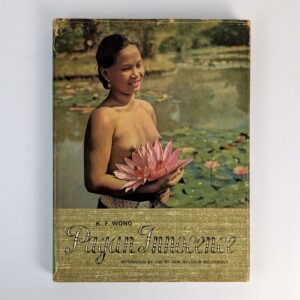
Pagan Innocence
AU$200.00 Read MoreAdd to cartK. F. Wong
London: Jonathan Cape, 1960.Photobook of Sarawak’s indigenous peoples, the Dayak, taken in the late 1950s and published in London in 1960. 30 pages of text with an introduction by Malcolm MacDonald.
-
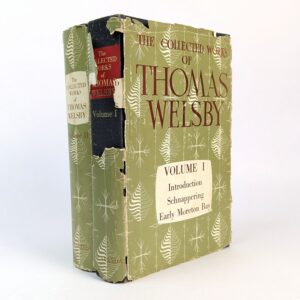
The Collected Works of Thomas Welsby
AU$150.00 Read MoreAdd to cartA. K. Thomson; Thomas Welsby
Brisbane: The Jacaranda Press, 1967. -
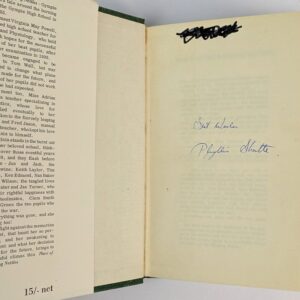
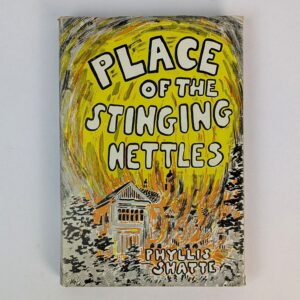
Place of the Stinging Nettles
AU$150.00 Read MoreAdd to cartPhyllis Shatte
Ilfracombe: Arthur H. Stockwell, 1970.A novel of Gympie, Queensland. This copy signed by the author.
-
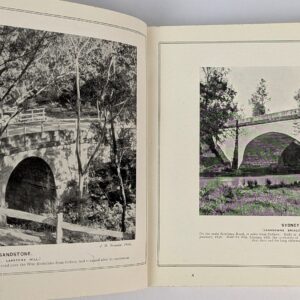
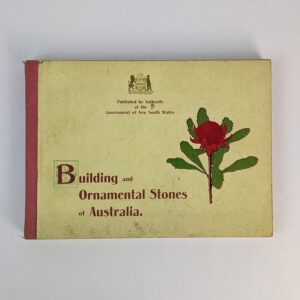
Building and Ornamental Stones of Australia
AU$100.00 Read MoreAdd to cartR. T. Baker
Sydney: Technological Museum, 1915.Technical Education Series, No. 20. Technological Museum, Sydney.
-
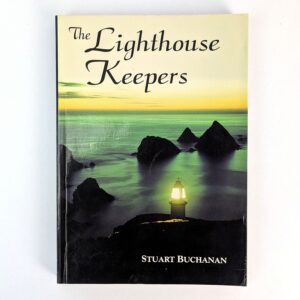
The Lighthouse Keepers
AU$30.00 Read MoreAdd to cartStuart Buchanan
Samford: Coral Coast Publications, 2000. -
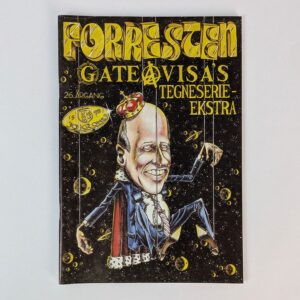
Gateavisa Nr. 154, Vintern 1996
AU$50.00 Read MoreAdd to cartGateavisa
Oslo: Futrum Forlag, 1996.Single issue of Norwegian anarchist and counterculture newspaper Gateavisa. First published in 1970 and through various forms and publishing schedules still being produced today. With an anti-authoritarian focus Gateavisa covered a wide range of topics, from occultism and mysticism to politics and philosophy, and of course underground comics. Gateavisa often featured stories on sex and drugs, and was an early supporter in an otherwise conservative Norway of LGBTQ rights and the legalisation of cannabis. Other regular columns ran on squatting, police violence, prisons, organic farming, pirate radios, punk, and more. This a special comics issue.
-
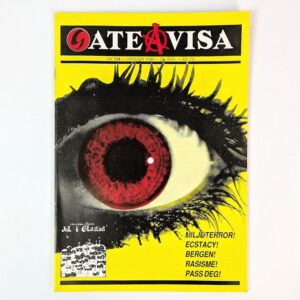
Gateavisa Nr. 124, Vintern 1989
AU$50.00 Read MoreAdd to cartGateavisa
Oslo: Futrum Forlag, 1989.Single issue of Norwegian anarchist and counterculture newspaper Gateavisa. First published in 1970 and through various forms and publishing schedules still being produced today. With an anti-authoritarian focus Gateavisa covered a wide range of topics, from occultism and mysticism to politics and philosophy, and of course underground comics. Gateavisa often featured stories on sex and drugs, and was an early supporter in an otherwise conservative Norway of LGBTQ rights and the legalisation of cannabis. Other regular columns ran on squatting, police violence, prisons, organic farming, pirate radios, punk, and more. This issue with a feature story on MDMA.
-
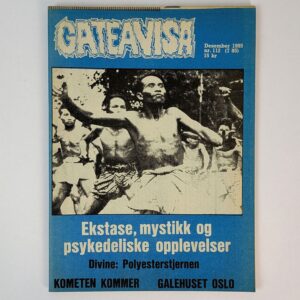
Gateavisa Nr. 112, December 1985
AU$50.00 Read MoreAdd to cartGateavisa
Oslo: Futrum Forlag, 1985.Single issue of Norwegian anarchist and counterculture newspaper Gateavisa. First published in 1970 and through various forms and publishing schedules still being produced today. With an anti-authoritarian focus Gateavisa covered a wide range of topics, from occultism and mysticism to politics and philosophy, and of course underground comics. Gateavisa often featured stories on sex and drugs, and was an early supporter in an otherwise conservative Norway of LGBTQ rights and the legalisation of cannabis. Other regular columns ran on squatting, police violence, prisons, organic farming, pirate radios, punk, and more. This issue with a cover story on psychedelic experiences in traditional cultures.
-

Gateavisa Nr. 12, 1981
AU$60.00 Read MoreAdd to cartGateavisa
Oslo: Futrum Forlag, 1981.Single issue of Norwegian anarchist and counterculture newspaper Gateavisa. First published in 1970 and through various forms and publishing schedules still being produced today. With an anti-authoritarian focus Gateavisa covered a wide range of topics, from occultism and mysticism to politics and philosophy, and of course underground comics. Gateavisa often featured stories on sex and drugs, and was an early supporter in an otherwise conservative Norway of LGBTQ rights and the legalisation of cannabis. Other regular columns ran on squatting, police violence, prisons, organic farming, pirate radios, punk, and more. This, the Psycho Special Issue with a feature story on Timothy Leary.
-
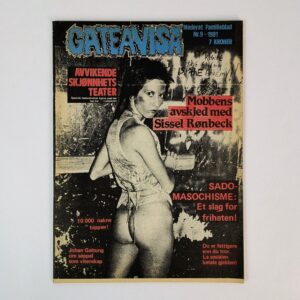
Gateavisa Nr. 9, 1981
AU$50.00 Read MoreAdd to cartGateavisa
Oslo: Futrum Forlag, 1981.Single issue of Norwegian anarchist and counterculture newspaper Gateavisa. First published in 1970 and through various forms and publishing schedules still being produced today. With an anti-authoritarian focus Gateavisa covered a wide range of topics, from occultism and mysticism to politics and philosophy, and of course underground comics. Gateavisa often featured stories on sex and drugs, and was an early supporter in an otherwise conservative Norway of LGBTQ rights and the legalisation of cannabis. Other regular columns ran on squatting, police violence, prisons, organic farming, pirate radios, punk, and more. This issue with feature stories on sado-masochism and lesbian SM.
-
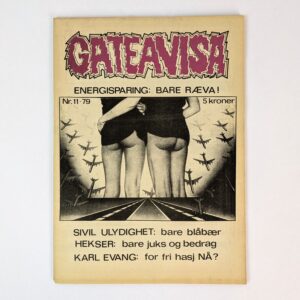
Gateavisa Nr. 11, 1979
AU$50.00 Read MoreAdd to cartGateavisa
Oslo: Futrum Forlag, 1979.Single issue of Norwegian anarchist and counterculture newspaper Gateavisa. First published in 1970 and through various forms and publishing schedules still being produced today. With an anti-authoritarian focus Gateavisa covered a wide range of topics, from occultism and mysticism to politics and philosophy, and of course underground comics. Gateavisa often featured stories on sex and drugs, and was an early supporter in an otherwise conservative Norway of LGBTQ rights and the legalisation of cannabis. Other regular columns ran on squatting, police violence, prisons, organic farming, pirate radios, punk, and more. This issue with a feature story on Sten Larris’ Forbyde Hallucinogener [Forbidden Hallucinogens].
-
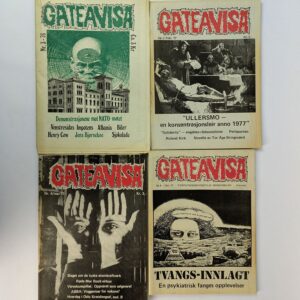
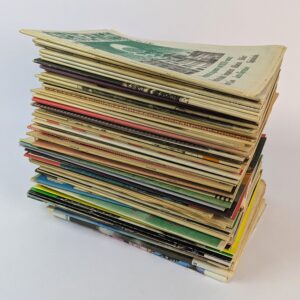
Gateavisa (69 Issues, 1976-1992)
AU$1,500.00 Read MoreAdd to cartGateavisa
Oslo: Futrum Forlag, 1976-1992.Broken run of 69 issues of Norwegian anarchist and counterculture newspaper Gateavisa. First published in 1970 and through various forms and publishing schedules still being produced today. With an anti-authoritarian focus Gateavisa covered a wide range of topics, from occultism and mysticism to politics and philosophy, and of course underground comics. Gateavisa often featured stories on sex and drugs, and was an early supporter in an otherwise conservative Norway of LGBTQ rights and the legalisation of cannabis. Other regular columns ran on squatting, police violence, prisons, organic farming, pirate radios, punk, and more. This run (from March 1976 to March 1992) largely comes from its heyday when it was produced monthly in the late 1970s and early 1980s, though it also shows the editorial changes the magazine went through in the late 1980s and early 1990s.
-
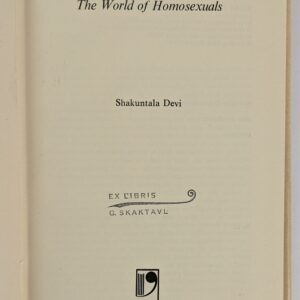

The World of Homosexuals
AU$3,000.00 Read MoreAdd to cartShakuntala Devi
New Delhi: Vikas Publishing House, 1977.Considered the first published academic study of homosexuality in India, though in the introduction Devi states it is “the work of a lay person for lay people”. The World of Homosexuals begins with a lengthy interview with a closeted homosexual and ends with a strong call for decriminalisation of homosexuality, “nothing less than full and complete acceptance will serve–not tolerance and not sympathy. By our attitudes and our actions we must make it possible for homosexuals to come out of hiding, to live their lives secure in their right to be themselves.” Shakuntala Devi (1929-2013) was an Indian mental calculator and writer, popularly known as the ‘Human Computer’ for her Guinness World Record holding speed arithmetic skills. In a documentary Devi claimed that she wrote the book as a result of her marriage to a gay man, though this claim was later refuted by her daughter and son in law, stating that Devi likely just said it as a good selling point, and perhaps also as a petty swipe at her ex-husband. Regardless of intention or spin, the book is an important and scarce source of latter 20th century Indian LGBTQ+ perspectives and history.
-
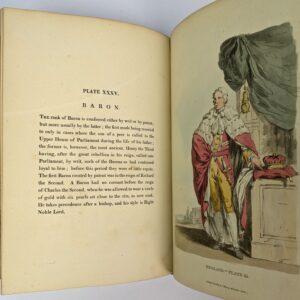
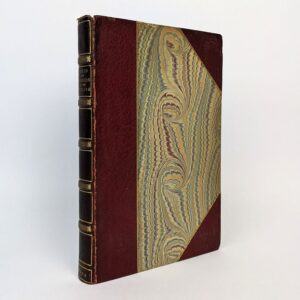
Picturesque Representations of the Dress and Manners of the English
AU$1,000.00 Read MoreAdd to cart[William Alexander]
London: John Murray, 1814.50 persons from across early 19th century English society are depicted in fine hand-coloured costume plates dated 1813, each accompanied by a detailed descriptive text. This copy in a signed Zaehnsdorf binding and with the bookplate of Ada Thatcher Huntzinger
-
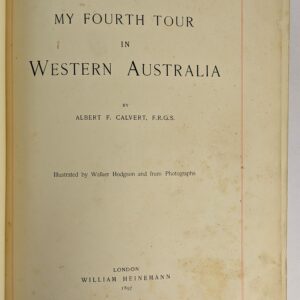

My Fourth Tour in Western Australia
AU$300.00 Read MoreAdd to cartAlbert F. Calvert
London: William Heinemann, 1897.The first edition of Calvert’s fourth tour of Western Australia. An early travelogue with hundreds of illustrations by Walker Hodgson, from photographs, and with a folding colour map showing the gold field regions. FERGUSON 7823.
-
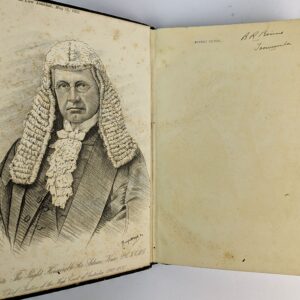
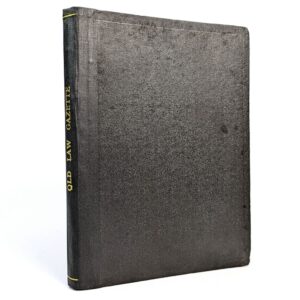
Queensland Law Gazette, Vol. 1, No. 1-4, 1930-31
AU$150.00 Read MoreAdd to cartL. Brown; W. Elson-Green; S. T. Halpin
Brisbane: Queensland Law Students’ Association, 1930-31.The first 4 numbers of the QLD Law Gazette being the entirety of volume 1, bound in 1 volume, with 3 page index at rear. Ownership stamp and signature of Rupert Beirne, Toowoomba, son of solicitor and first native-born Mayor of Toowomba, B. J. Beirne, and with a plate depicting Chief Justice Adrian Knox to the front pastedown
-
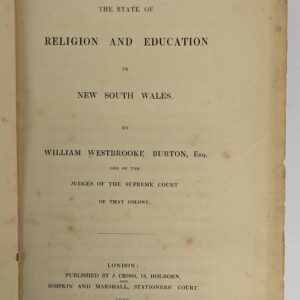
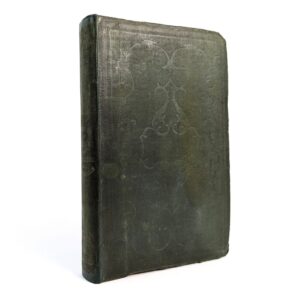
The State of Religion and Education in New South Wales
AU$200.00 Read MoreAdd to cartWilliam Westbrooke Burton
London: J. Cross and Simpkin and Marshall, 1840.This copy from the collection of Melbourne bibliophile Rollo Hammet, with his label, and the ownership signature of W. Champion Hackett. FERGUSON 2943.
-
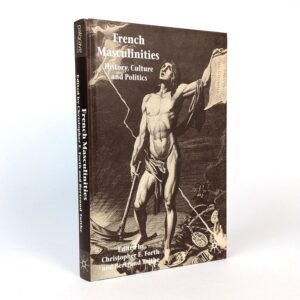
French Masculinities: History, Culture and Politics
AU$100.00 Read MoreAdd to cartChristopher E. Forth; Bertrand Taithe
Basingstoke and New York: Palgrave Macmillan, 2007.This copy inscribed by Christopher Forth
